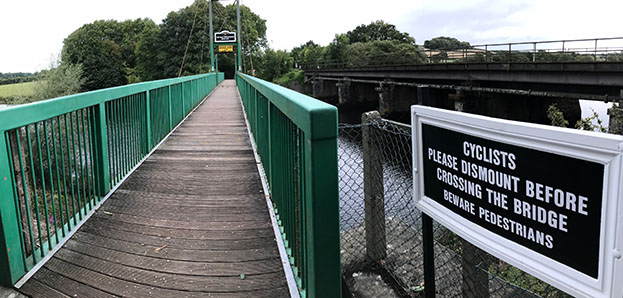SOUTH DEVON RAILWAY EMBROILED IN FOOTBRIDGE ROW
Published at 00:00 on Thursday 30th August 2018
Tags: South Devon Railway, Cycle Path, Devon County Council

The SDR's private footbridge that connects Totnes with its Littlehempston station and the Rare Breeds Farm is under threat of being used as part of a new cycleway, affecting the safety of passengers and the security of the station Littlehempston Parish Council
The South Devon Railway is currently embroiled in a row with Devon County Council over the latter’s proposal to use the Railway’s private footbridge that crosses the River Dart to provide access to its Totnes Littlehempston station as part of a new long distance cycle route.
The Railway is facing strong criticism by the Council in the local press over its refusal to allow 24-hour cycle access across the bridge, but believes its position is justified on several grounds. In particular, the bridge varies in width between 1.8m and 2m, and the minimum recommended width for shared use paths in all highway design standards (such as Sustrans documents and Highways England’s authoritative Design Manual for Roads and Bridges) is three metres, other than at localised pinch points such as adjacent to street furniture. Based on the guidelines it is undisputable that the bridge is over 30% narrower than the minimum recommended standard, and over a considerable length. The Railway’s concerns of the hazards that could be posed to the 25,000 passengers and a similar number of visitors to the Rare Breeds Farm that use the bridge annually can be fully appreciated, particularly in view of the fact that a number of highway authorities’ legal departments across the country are now refusing to adopt such features where the three-metre minimum width cannot be provided.
There is also the risk of the security of its station site, which has been lovingly constructed from scratch over the years, and is now regarded as something of a GWR style gem. The use of the private footbridge as a public right of way for cycles and pedestrians would require it to be open 24 hours a day, every day of the year, and the Railway feels that this could encourage antisocial behaviour and vandalism of its property, as has been experienced at a number of other lines.
The Council is arguing that the footbridge was funded from the public purse, and this is partly accurate – the structure was built in 1993 at a cost of £165,000, with £10,000 each being contributed in the form of grants by the Countryside Commission, Devon County Council, the British Rail Community Unit, South Hams District Council and Dartmoor National Park, with the Rural Development Commission contributing £40,000 and the lion’s share of £75,000 being made by the Railway itself. However, the Railway is now the outright owner of the bridge and is solely responsible for its upkeep. It is the only available access to the station other than by rail, as the adjacent road cannot be used due to being privately owned by South West Water and is narrow, steep and used by its heavy goods vehicles to access the water treatment works.
Railway Spokesman, Dick Wood, commented: “While we actively support green transport, and welcome cyclists at our stations and on our trains regularly (we even have a lockable bike rack at Totnes), we are taking an entirely reasonable stance that the partnership of like-minded local councils, authorities and interested parties that funded and built the footbridge, now known as ‘Bulliver Bridge', in 1993 did so solely in order to help develop local tourism by providing a footbridge to link the South Devon Railway with Totnes, and it is simply not suitable for a cycle path mixing with pedestrians.”
While the County Council claims that all other landowners in the area are now behind the plans, the Rare Breeds Farm has also confirmed that it is opposed to them and is supportive of the Railway’s stance. The option to use the existing bridge, rather than building a new one to the required standard, is likely to be around £500,000 cheaper for the Council but the costs of providing an increased maintenance regime for the structure, together with improved security for the Railway and the other landowners affected by the new cycle route, will almost certainly exceed this figure. With local highway authorities now under increased pressure to provide new cycle and recreational facilities despite heavy funding cuts, the choice of using an existing bridge for a new route is an understandable one but the risks of cutting corners as well as costs must be carefully considered. Railway Herald has approached Devon County Council for comment, with detailed questions having been asked regarding the road safety issues raised by the Railway. However, to date the Council has declined to answer any of the questions put forward.
Elsewhere on the line, there is good news for the forthcoming 50th Anniversary Gala planned for April next year, with GWR 1400 class 0-4-2T No. 1450 and autocoach No. 178, both owned by Mike Little and normally based on the Severn Valley Railway, confirmed as visiting for the event, joining GWR 6400 class 0-6-0PT No, 6430 from Llangollen.

